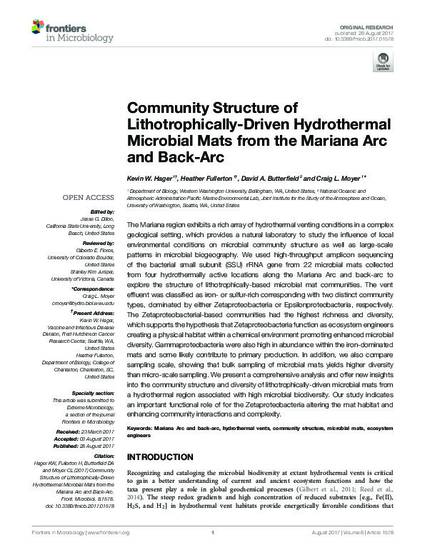
- Marian Arc and back-arc,
- Hydrothermal vents,
- Community structure,
- Microbial mats,
- Ecosystem engineers
The Mariana region exhibits a rich array of hydrothermal venting conditions in a complex geological setting, which provides a natural laboratory to study the influence of local environmental conditions on microbial community structure as well as large-scale patterns in microbial biogeography. We used high-throughput amplicon sequencing of the bacterial small subunit (SSU) rRNA gene from 22 microbial mats collected from four hydrothermally active locations along the Mariana Arc and back-arc to explore the structure of lithotrophically-based microbial mat communities. The vent effluent was classified as iron- or sulfur-rich corresponding with two distinct community types, dominated by either Zetaproteobacteria or Epsilonproteobacteria, respectively. The Zetaproteobacterial-based communities had the highest richness and diversity, which supports the hypothesis that Zetaproteobacteria function as ecosystem engineers creating a physical habitat within a chemical environment promoting enhanced microbial diversity. Gammaproteobacteria were also high in abundance within the iron-dominated mats and some likely contribute to primary production. In addition, we also compare sampling scale, showing that bulk sampling of microbial mats yields higher diversity than micro-scale sampling. We present a comprehensive analysis and offer new insights into the community structure and diversity of lithotrophically-driven microbial mats from a hydrothermal region associated with high microbial biodiversity. Our study indicates an important functional role of for the Zetaproteobacteria altering the mat habitat and enhancing community interactions and complexity.
The Supplementary Material for this article can be found online at: https://www.frontiersin.org/article/10.3389/fmicb.2017.01578/full#supplementary-material
The Supplementary Materials is also available as additional files on this page.

The Supplementary Material for this article can be found online at: https://www.frontiersin.org/article/10.3389/fmicb.2017.01578/full#supplementary-material
The Supplementary Materials is also available as additional files on this page.